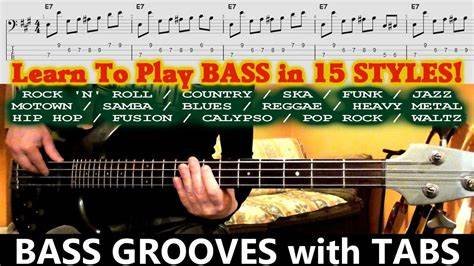Playing bass in different music genres requires versatility and a good understanding of each style’s unique demands. Each genre has its own techniques, groove, and feel. Here’s a guide to mastering bass across a variety of music styles.
1. Rock
Rock music emphasizes power and rhythm, making the bass a driving force.
- Techniques to Use: Focus on alternate picking or fingerstyle.
- Role of the Bass: Lock in with the drums, particularly the kick drum, to create a solid foundation.
- Famous Example: Listen to John Paul Jones of Led Zeppelin for inspiration.
2. Jazz
Jazz bass requires improvisation and a deep understanding of harmony.
- Techniques to Use: Master walking basslines and arpeggios.
- Role of the Bass: Connect the rhythm and melody while improvising around chord changes.
- Famous Example: Explore the works of Charles Mingus for jazz bass mastery.
3. Funk
Funk bass is all about groove, syncopation, and rhythmic precision.
- Techniques to Use: Practice slap and pop techniques to add percussive elements.
- Role of the Bass: Create infectious grooves that lead the rhythm section.
- Famous Example: Study the playing of Bootsy Collins for funky basslines.
4. Blues
Blues basslines often use repetitive patterns and follow the 12-bar blues structure.
- Techniques to Use: Focus on walking basslines and simple, steady rhythms.
- Role of the Bass: Support the chord progression and enhance the soulful feel.
- Famous Example: Listen to Willie Dixon’s recordings for classic blues bass.
5. Reggae
Reggae bass is characterized by deep, melodic grooves.
- Techniques to Use: Use fingerstyle playing with a strong emphasis on the offbeat.
- Role of the Bass: Drive the rhythm with syncopated, low-end riffs.
- Famous Example: Aston “Family Man” Barrett’s work with Bob Marley is essential listening.
6. Pop
Pop basslines are often simple yet catchy, designed to complement the vocals.
- Techniques to Use: Use a mix of fingerstyle and picking for clarity.
- Role of the Bass: Provide a solid rhythmic and harmonic base that supports the melody.
- Famous Example: Paul McCartney’s basslines with The Beatles offer timeless lessons.

7. Metal
Metal bass demands speed, precision, and a powerful tone.
- Techniques to Use: Practice fast picking and alternate picking techniques.
- Role of the Bass: Strengthen the heavy guitar riffs and add depth to the sound.
- Famous Example: Cliff Burton of Metallica exemplifies exceptional metal bass playing.
8. Country
Country basslines often follow simple patterns that emphasize the root and fifth notes.
- Techniques to Use: Use fingerstyle for a warm tone.
- Role of the Bass: Maintain a steady rhythm that complements the storytelling aspect of country songs.
- Famous Example: Check out Roy Huskey Jr.’s contributions to country music.
9. R&B and Soul
R&B basslines are smooth, melodic, and groove-driven.
- Techniques to Use: Focus on fingerstyle and slides for a silky sound.
- Role of the Bass: Lay down grooves that make the music feel smooth and soulful.
- Famous Example: James Jamerson’s work for Motown is a masterclass in R&B bass.
10. Electronic
Electronic bass often incorporates synth-like tones and effects.
- Techniques to Use: Experiment with pedals and electronic effects.
- Role of the Bass: Provide rhythmic and harmonic support with a futuristic sound.
- Famous Example: Listen to modern electronic tracks for innovative bass approaches.
Mastering bass techniques across genres requires understanding diverse rhythmic patterns, much like how strategic approaches can enhance your experience in various gaming platforms. For those interested in exploring different forms of entertainment, the wolf winner australia online casino offers a dynamic environment that parallels the adaptability needed in music performance.
Whether you’re laying down a solid groove in funk or driving the rhythm in metal, versatility is key. Just as a skilled bassist navigates chord changes, players in diverse settings appreciate seamless transitions and engaging features.
Developing your skills across genres not only makes you a more rounded musician but also opens up new creative possibilities, similar to discovering innovative gaming experiences that keep the excitement alive.
Conclusion
Each music genre offers unique challenges and opportunities for bass players. By mastering techniques specific to each style, you can become a versatile musician capable of adapting to any musical setting. Explore, practice, and most importantly, enjoy the journey of bass playing across genres.







